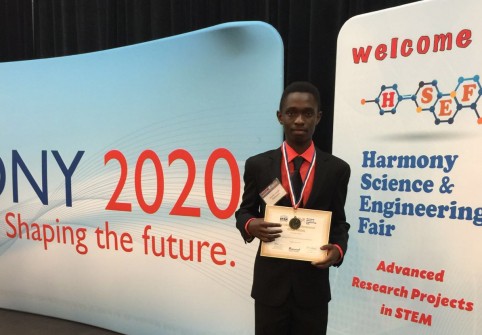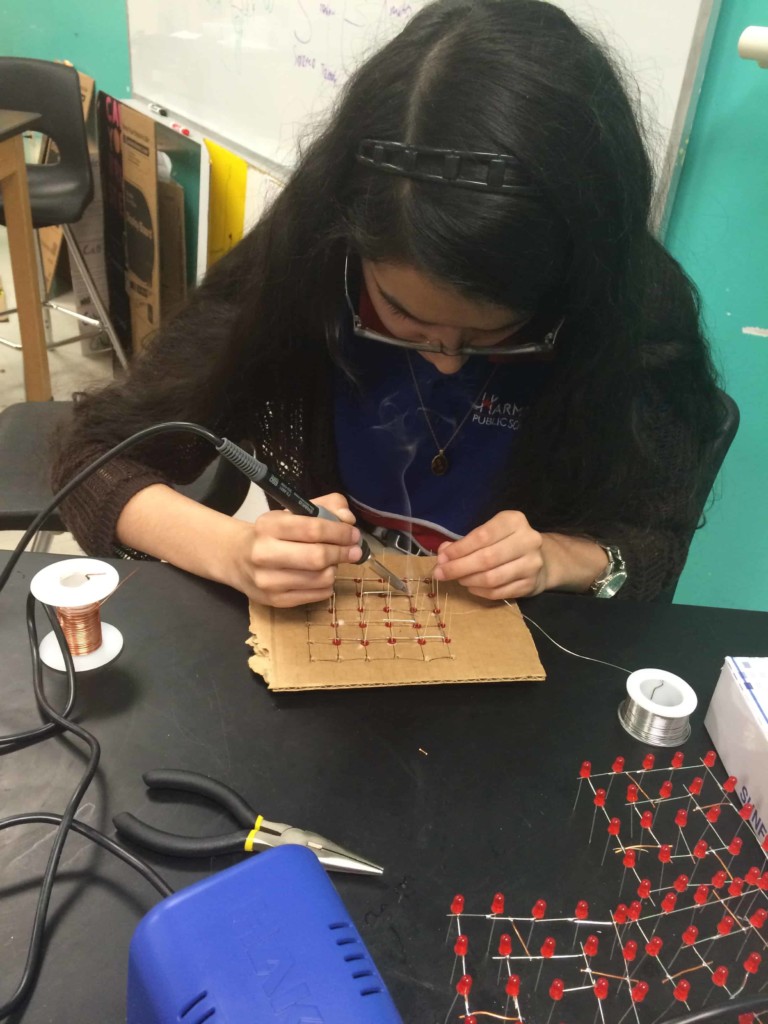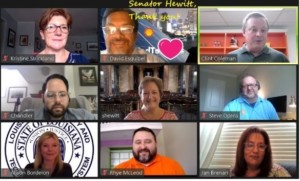Putting the “Learner” in Learner-Centered STEM

High school freshman Arnold Langat investigated the role of radio-magnetic frequencies on the grazing habits of animals. He won the school network-wide science fair, took the leading prize at the Fort Worth Regional Science Fair, and will now compete in the State Science Fair in San Antonio and on the world stage at the I-SWEEEP in Houston. Of course not all students in Harmony Public Schools take the top prize, but each of the 30,000 students in 46 Harmony schools do have the same opportunities as Arnold. That’s because they’re in a school that focuses on Learner-Centered STEM–a model of learning that is possible at scale for all students.
We invited the Harmony community to describe the learner experience–what learning looks and feels like for students, how that differs from learning in a traditional classroom and why this makes Learner-Centered STEM a powerful way to learn!
What Do Students Say?
We heard from students that it comes down to these four things:
- Academic Support
- Positive School Culture
- Relationships
- Focus on College, Career and Life
Academic Support. “It is a school that allows me to use my full potential. The classes are challenging and varied; the teachers are helpful and their techniques for teaching are the best. After school programs are interesting, educational and a fun way to expend your time. There are many students that don’t know how to speak, write or read English like me, and they provide a lot of help for us. They provide help for the students who have learning problems.” Lorena G., 11th grader at Harmony Science Academy-North Austin, 11th Grade
“I have the opportunity to get one-on-one help from teachers and counselors. I can visit the counselor anytime I want.” Jesus R., Harmony Science Academy Brownsville, 8th grade
Positive School Culture. “This is a small and safe environment. Here everybody knows each other and the teachers are really helpful, as compared to other schools where there are too many students for the teachers to really pay attention to every single one of them. To them you are just a number. I have been in Harmony since I was in the 4th grade and it’s been great getting to know a lot of people. It is also the best place for me because you really form a bond with the friends that you make in school and you can learn together, and it’s just a good place to be.” Gabriella O., Harmony Science Academy-North Austin, 10th Grade
“I choose Harmony because of all my friends and family that told me it was a good school. When I came, I saw that it was all true. Everyone was nice and helpful. It’s a privilege to go to a school like this. Teachers treat you like a real person. School is fun and they have so many fun activities. I also love that they support no bullying which is a great policy.” Anonymous Harmony Student
Relationships. “There is a lot of diversity at the school. I have been exposed to many languages and cultures that I wouldn’t have even heard of if I didn’t go to Harmony school. I have also made a lot of friends that I have cultural ties with, something none of my friends that don’t go to Harmony has been able to say. The classes are small so you really get to know your classmates and are able to interact with your teachers to do better in school. There are actually a lot of things to do at the school, we just have to work together and get them ourselves, which has perks to teach kids to work for something they want. Overall I have many stories and interesting experiences coming from my 7 years at this school.” Naurin N., Harmony Science Academy-North Austin, 11th Grade
Focus on College, Career and Life. “Teachers and staff make sure I get a good education and care about my life and future which is an extra support to succeed in college and life.” Brenda, Harmony Science Academy-El Paso, 11th grade
“Harmony is a good place for me because it gives me opportunities that I want to achieve in my future career. I get an excellent explanation of how the real world will be like.” E. Montano, Harmony Science Academy San Antonio student
“It helps me grow as a student and citizen.” Anonymous 12th Grade Student, Harmony Science Academy
What Do Teachers Say?
Across the network, Harmony teachers described the learner experience in many ways, confirming what students had to say about their own experiences as learners. They described Learner-Centered STEM as:
- “Student centered and active learning through hands-on projects where students take charge of their own learning through research, collaboration and dialogue with peers.”
- “Hands on learning and relevance to daily life.”
- “Student-led, problem-solving classrooms.”
-
“Structured chaos as students work on projects and discuss and collaborate.”
-
“Individualized learning opportunities.”
-
“Authentic research on weekly basis.”
-
“Students following their own interests and ideas and incorporating those things into their studies.”
-
“Student driven and personal.”
-
“Peer to peer interaction via project based learning.”
-
“Students aspiring to expand their views.”
-
“Personalized and highly STEM-focused.”
-
“Authentic and relevant.”
Strategies for Creating a Learner-Centered STEM Environment
A truly learner-centered model doesn’t happen without instructional strategies that empower and engage students.
Harmony Instructional Coach Robert Thornton explains, “Within classrooms that truly implement the Harmony model, learning looks like students engaging students within a safe intellectual environment that is planned, structured and supported by a teacher. At its best you will observe students who are excited to share their learning gains with their teacher. Not right answers but actual, sometimes painful, strides forward in academic skill.”
Harmony Project Director Burak Yilmaz adds, “Learning looks fun and engaging in Harmony thanks to our unique PBL approach. (See STEMSOS.com for more info on the model.) From what I observe in the classrooms, it feels authentic and relevant to students. They feel like what they are learning matters and they feel and express their growth through projects both academically and socially. They get to be vocal about their learning and use data and arguments to support their reasoning. They get to form and test hypotheses and share their findings with peers and teachers. Their learning is experiential and dynamic, not static like memorizing mere facts and formulas as we typically see in traditional settings.”
Creating and sustaining an environment that looks like this takes dedication, time and energy. Teachers play a vital role in making the Harmony vision a reality for students.
 We’ll focus more on teachers and their role as learning facilitators in the next blog in our “Getting Smart on Learner-Centered STEM” series. So far we’ve learned from engaging with the Harmony community that in a learner-centered model, teachers and leaders must:
We’ll focus more on teachers and their role as learning facilitators in the next blog in our “Getting Smart on Learner-Centered STEM” series. So far we’ve learned from engaging with the Harmony community that in a learner-centered model, teachers and leaders must:
- Act as Facilitators and Guides
- Provide Anytime, Anywhere and On-Demand Support
- Embody Core Values
- Truly Encourage Students Drive Their Own Learning
- Create Real-World and Authentic Learning Experiences
- Leverage Technology to Personalize Learning
- Commit to Professional and Personal Growth
Make no mistake; being a student, teacher or leader in a Harmony Public School isn’t easy. Expectations are high across the board. It’s this balance of “high press and high support” that creates the conditions where both kids and adults thrive. Nearly every teacher we connected with had a story to tell that confirmed why everyone is willing to put forth the effort.
From the ELL student who struggled through middle school Math then by tenth grade decided to pursue a STEM major in college, to the student who was sure he could disprove Einstein and was encouraged to do so. There was the young student who said she had never imagined she would take AP Physics, then went on to pass after completing a PBL STEM project that she was so proud of she said she would share it with her grandchildren. There’s the student who started off disengaged and disinterested who, thanks to commitment and collaboration between the teachers and his family, went on to earn third place in the Regional Science Fair and later a Silver Medal with his Coding project using Scratch, and gained a newfound confidence and motivation to succeed.
While Harmony Public Schools have the tools and technology to create next-gen learning experiences, it’s not the 3D printers or Chromebooks that make the STEMSOS model work for students. It’s a system that puts–and keeps–students at the center.
For more see:
- 11 Key Elements of Learner-Centered STEM
- Learner-Centered Vision Will Frame Next Generation Learning
- 10 Teacher Moves to Build Student Support in a PBL Classroom
This post is a part of a blog series in the upcoming “Getting Smart on Learner-Centered STEM” Smart Bundle produced in partnership with Harmony Public Schools (@HarmonyEDU). Join the conversation on Twitter using #STEMSOS.
Stay in-the-know with all things EdTech and innovations in learning by signing up to receive the weekly Smart Update. This post includes mentions of a Getting Smart partner. For a full list of partners, affiliate organizations and all other disclosures please see our Partner page.







0 Comments
Leave a Comment
Your email address will not be published. All fields are required.